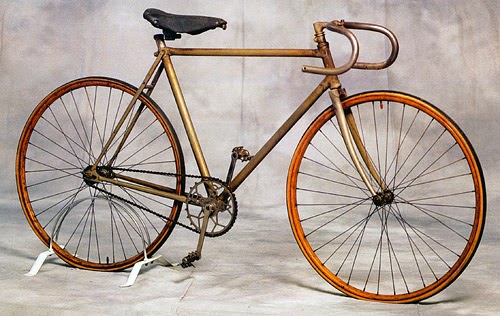The following is a reprint from the Wednesday, August 13, 2014 edition of eSkeptic Magazine. It's interesting how we accept things the way they always have been without questioning why, or how it could be different. In fact, some early inventions have withstood the test of time and very little has changed in them. The article takes a small look.
A Two
Wheeled Path
By Michael
Shermer
Path
dependency is an economic concept to describe what happens when a technology
becomes stuck in a market pathway out of historical momentum, especially when
the transactions costs of changing course are too high. The QWERTY keyboard is
the most popular example of the phenomenon. As the standard narrative has it,
QWERTY got a head start in the late 19th century over other keyboard
arrangements that were vastly superior and so now we are stuck with this clunky
keyboard system because of historical lock in.
Baloney.
The QWERTY keyboard may not be the best of all possible letter key
arrangements, but it has consistently held up against all would-be competitors
because it is good enough to get the job done compared to costs of changing
technologies for miniscule margins of improvement. What happens in most
technologies is that the earliest innovators make most of the significant
design features, which later generations tinker with and modify for
improvements, and change happens mostly for convenience or efficiency factors,
and not because of initial serious design flaws.
The bicycle
is a case study in how technologies evolve, evidence for which is in abundant
supply in Tony Hadland’s and Hans-Erhard Lessing’s encyclopedic history of bicycle
design. This
marvelous book features over 300 illustrations culled from many sources, most
intriguingly from patent records. Having lived through what I thought was a major
revolution in cycling technology in the 1980s when I was competing in the
3000-mile nonstop transcontinental bicycle Race Across America, I discovered in
Bicycle Design that most of that decade’s innovations (as well as those in the
decades hence), were invented, designed, and in many cases patented by cycling
innovators decades or even a century before.
Today’s Tour de France professionals are riding machines whose fundamental design can be seen in Starley and Sutton’s 1885 Rover Safety bike, in the 1892 Sunbeam Special Light Road Racer, in Raleigh’s 1939 Carlton Flyer, and others: the diamond shaped frame with a top tube between the seat and handlebars, a head tube holding the handlebars and the fork for the front wheel, a down tube between the head tube and the bottom bracket for the pedals and drive train, and a seat tube between the seat and bottom bracket. The wheels are equal in size and the cyclist sits upright and propels the bike forward by means of pedaling a chain ring around which a chain turns a set of cogs attached to the rear wheel. Steering is done by controlling the front wheel and brakes are affixed to both wheel rims with controls on the handlebars.
The diamond frame design with an upright pedaling cyclist is not a quirk of history, nor is it a suboptimal design foisted upon us by path dependency. The design works because of human anatomy. In terms of propelling a body forward under human power, no one has come up with a better design for all terrains in a century of innovation. The closest thing to a revolutionary re-design is the recumbent bike with the cyclist positioned in a supine (horizontal) position. Recumbents are advantageous on flat surfaces, but they also have distinct disadvantages on climbs and rough terrain—I know because I rode the recumbent Gold Rush across America in 1989. In any case, Bicycle Design features illustrations (and patent numbers) for recumbents that date back to the 1890s, so it’s had over a century to displace its primary competitor.
What about bicycle components, accessories, and materials? When Greg LeMond became the first (and still only) American to win the Tour de France in the 1980s, we all thought he and his bike designers had invented, for example, clipless pedals, which we all adopted as new and revolutionary. But Bicycle Design features an illustration for patent No. 550,409 dated Nov. 26, 1895 for a clipless pedal system invented by Charles M. Hanson that looks every bit as efficient as what the pros ride today. What about the comfortable padded and yet efficient saddles people now ride? Hadland and Lessing include designs and patents for padded and spring-suspended saddles dating back to the late 19th century. How about those shock absorber and suspension systems featured on modern mountain bikes? See the 1869 French patent for a twin-fork front suspension system using leaf springs, or U.S. patent No. 97,683 for four forms of front wheel suspension invented by René Oliver. Spokes? Designs for compression spoke wheels were granted in 1867, 1868, and 1869 to seven different inventors. Similarly for derailleurs that shift gears: patents were first granted in 1868, with numerous multi-speed patents awarded in the 1890s. Disk brakes used by mountain bikers were patented a century ago.
Of course, as Hadland and Lessing point out, “just because something was patented doesn’t mean that it was widely adopted or even that it was put into production. It does, however, show that a problem and a solution were understood by someone at a particular time and in a particular place.” After that, numerous factors come into play that determine whether or not it becomes a commercial success: quality, efficiency, cost, marketing, but almost never path dependency.


No comments:
Post a Comment